Thai-style salmon mango curry brings together the richness of salmon, the sweetness of mango, and the bold spices of Thai red curry paste. If you love fish and Thai flavors, then this recipe is for you!
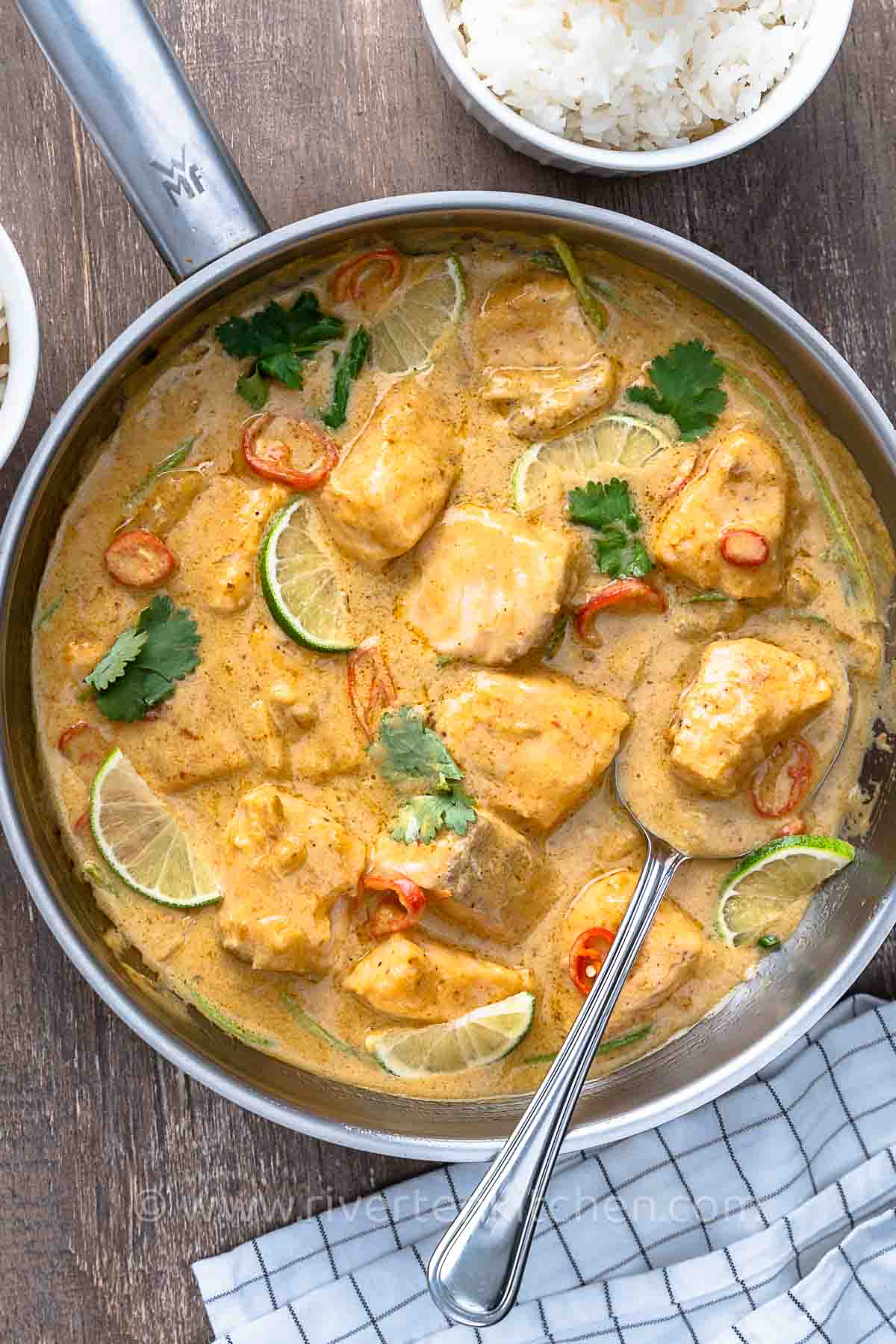
Why salmon is perfect for making fish curry?
- Salmon is nutritious and has a soft, buttery texture that makes it great for curries.
- It’s also firm enough to hold its shape during cooking, so it won’t fall apart.
- Salmon’s rich flavor goes well with the bold, fragrant spices in Thai curries. This creates a delicious mix of tastes – creamy, savory, sweet, and spicy.
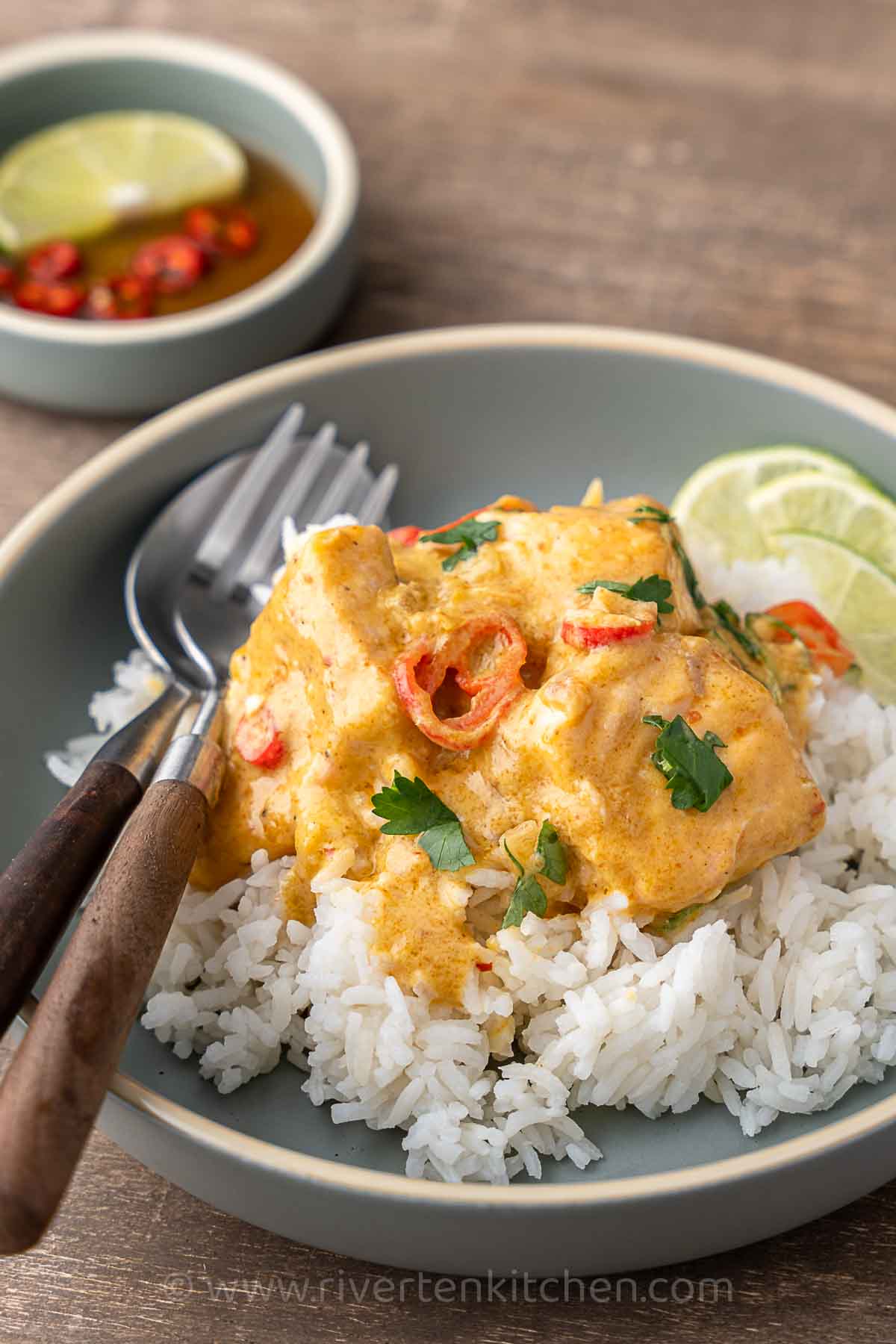
What you need
Here are the ingredients you need to make salmon mango curry:
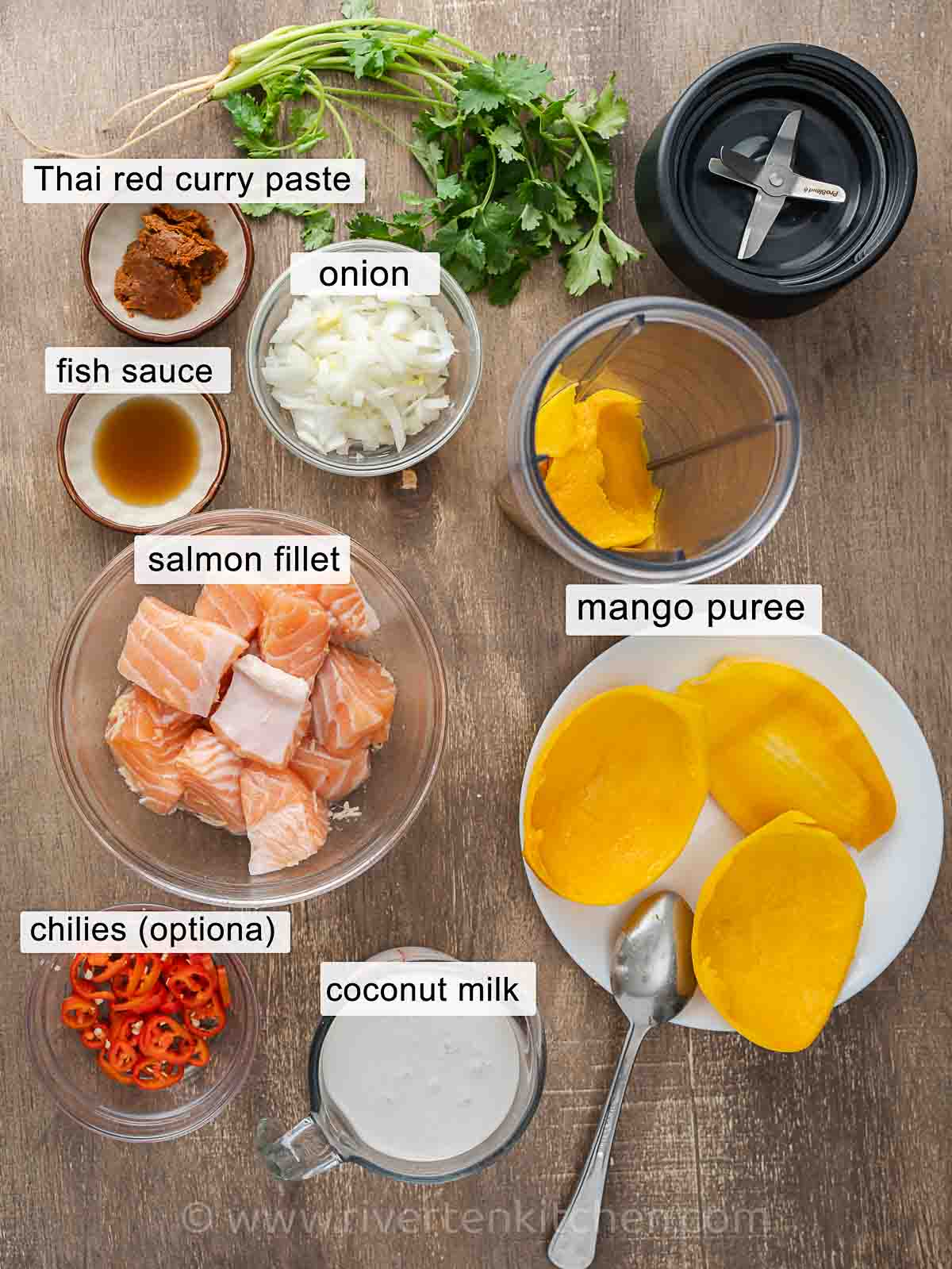
A few notes:
- Salmon fillets – Salmon is a good alternative to chicken for making curry dishes. It’s a rich source of protein, vitamin D, and omega-3 fatty acids.
- Thai red curry paste – made with chili peppers, garlic, ginger, lemongrass, and galangal. These ingredients combine to create a flavourful and slightly spicy sauce. You can buy this in most Asian stores and online.
- Onion, Garlic, and Ginger – Simple spices that you probably already have in your pantry. Use red onion or yellow onion alternatively.
- Ripe Mangoes – Fresh mangoes add a touch of sweetness to the curry. It also helps balance out the heat from the chili peppers.
- Coconut Milk – Use the purest form of coconut milk available. Look for brands that only have water as an added ingredient, and avoid those that contain thickeners or any other additives.
- Fish sauce – A staple when making Thai dishes. This adds depth of flavor and umami.
How to Make the Best Salmon Curry
Here are my top tips for making the most delicious salmon curry:
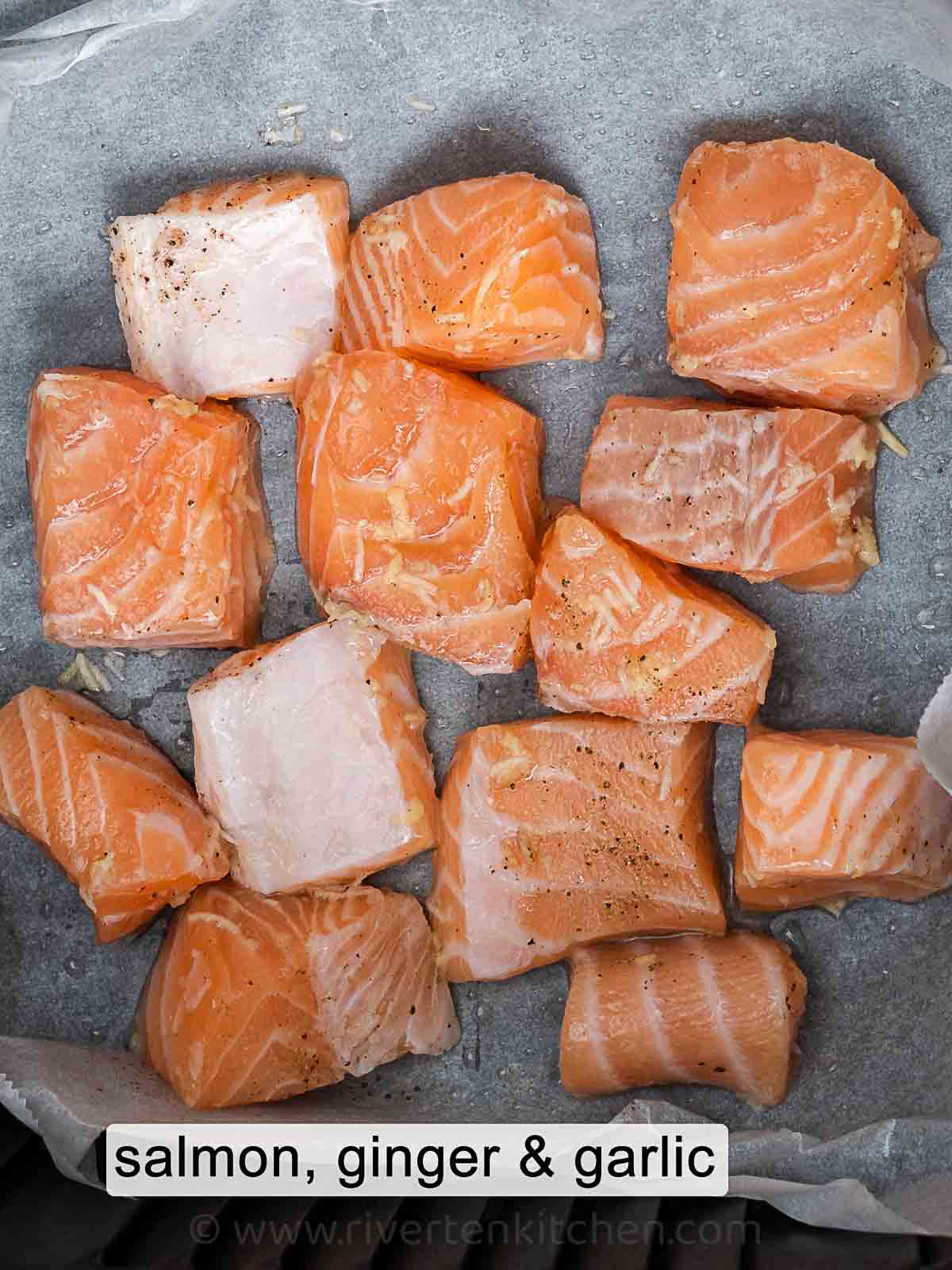
1. Marinate salmon pieces
Marinating the salmon in a mixture of grated ginger, garlic, salt, and pepper elevates the natural fish flavor while reducing any potential fishy smell. A brief marination of approximately 5 minutes should be enough. Use this time to prepare the remaining ingredients for the dish.
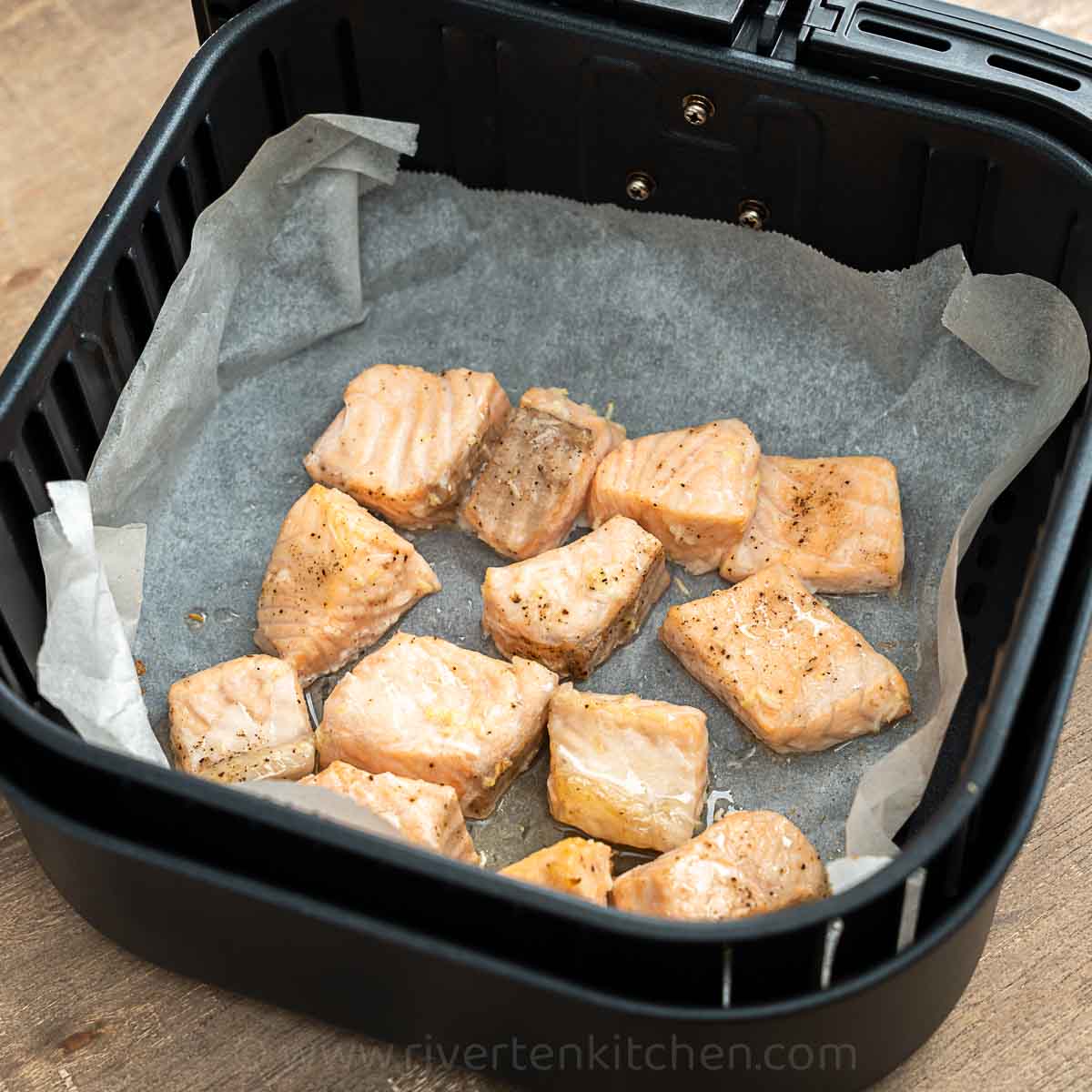
2. Partially cook the salmon
To give the salmon a firm texture, partially cook it by searing it in a pan or using an air-fryer or oven for easy clean-up. Here are the cooking times and temperatures:
- Air-fryer – Preheat the air-fryer for 3 minutes at 400°F/ 200°C. Air-fry the salmon for 5 minutes. You can line the basket with parchment paper for easy clean-up but note that the fish will sort of have a pale somewhat steamed texture rather than a crispy or browned texture.
- Oven – Preheat oven for 5 minutes at 425°F/ 220°C. Place salmon in a baking tray lined with greased parchment paper or foil. Broil for 5 minutes.
- Pan-sear – Heat a skillet over medium-high heat until very hot. Add the canola oil then swirl to coat. Add the salmon cubes and sear each side for 2 minutes until nice and brown. Use cooking tongs to flip the fish for convenience.
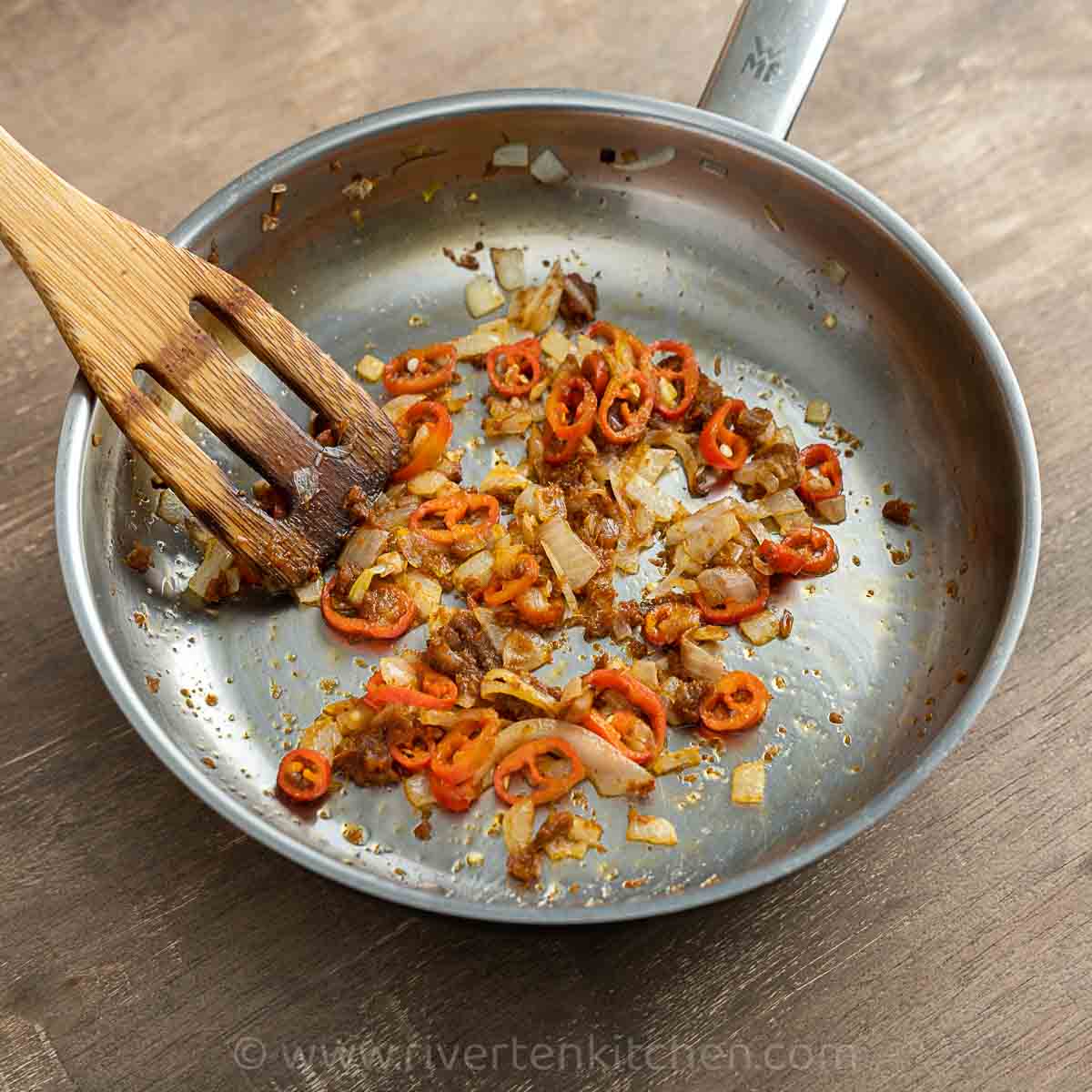
3. Sauté spices and red curry paste
The secret to making a good curry dish using store-bought curry paste is sautéing it in oil along with onion, chilies, garlic, and ginger. This cooking method allows the spices within the curry paste to fully develop and release their natural aroma, resulting in a flavorful and delicious curry.
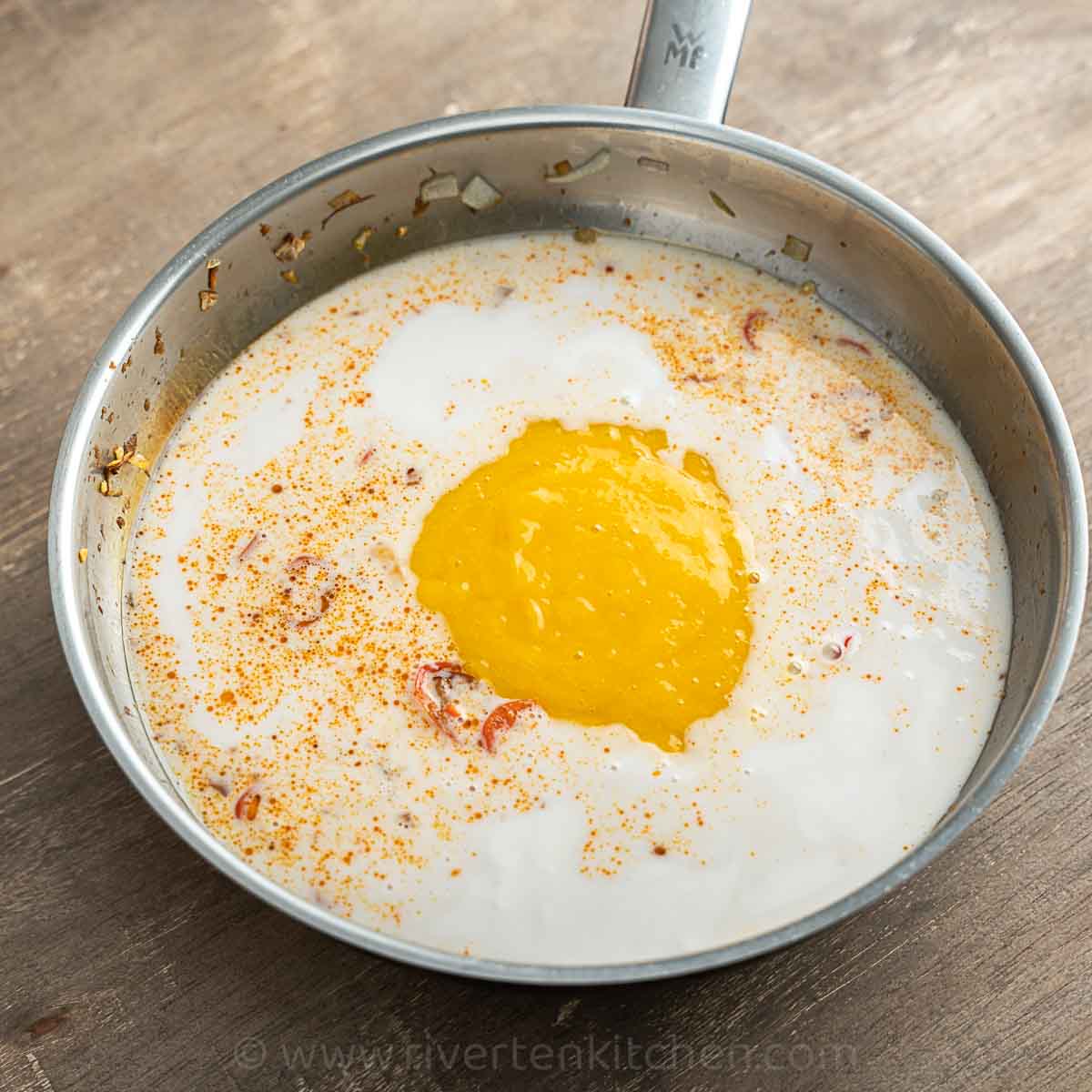
4. Simmer until thickened
When the curry paste and spices become fragrant and aromatic, add coconut milk, mango puree, and fish sauce. Simmer over medium heat until it thickens, about 3 minutes. Taste the sauce, and add more curry paste depending on your preferred level of spiciness. If the sauce becomes too thick, add a splash of hot water or chicken broth.
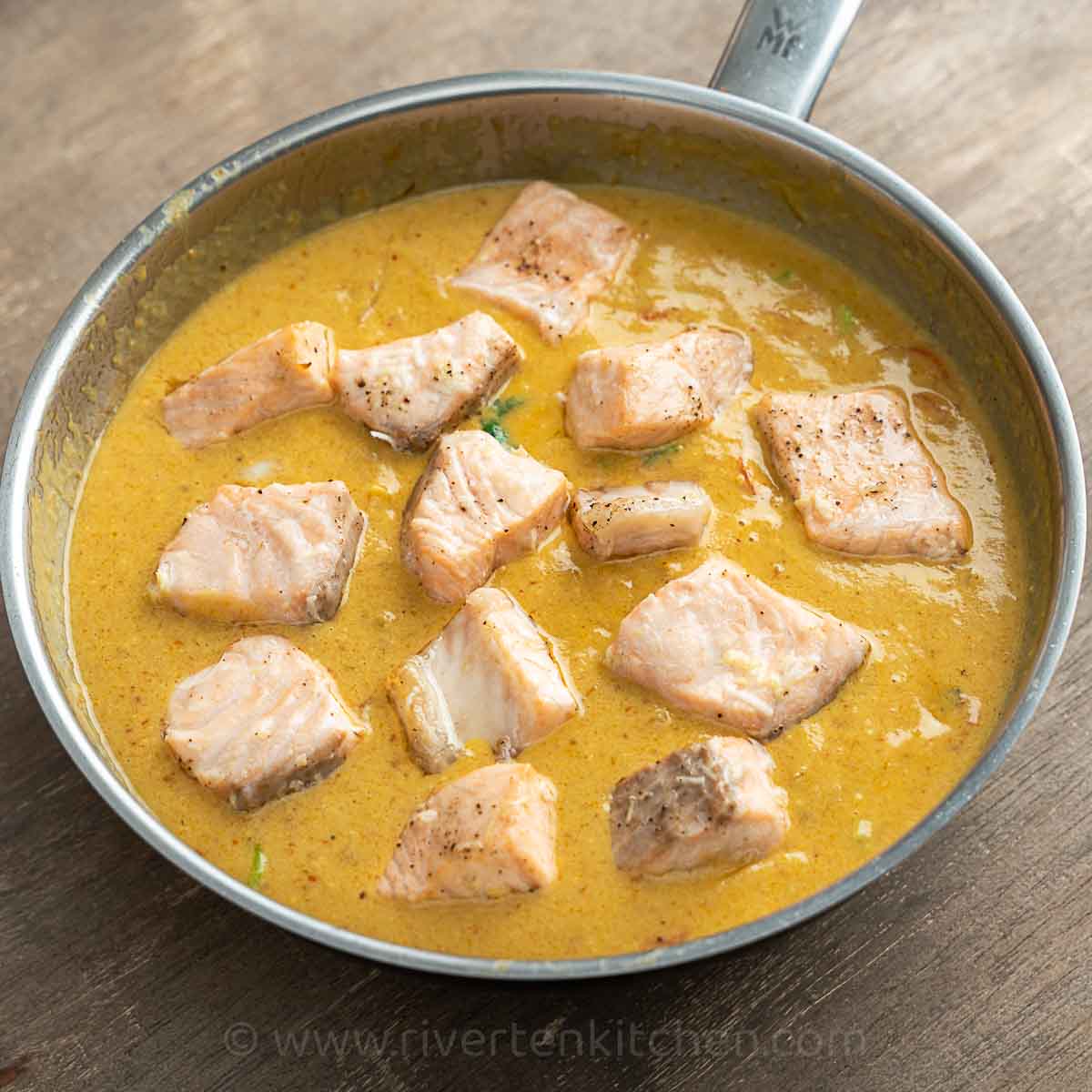
5. Finish cooking the salmon in the sauce
Once the mango curry sauce is creamy and velvety, add the salmon pieces and finish cooking it for around 2 to 3 minutes. Stir gently, ensuring to coat the fish with the sauce, allowing the flavors to meld together perfectly.
Remove from heat then top with fresh coriander or cilantro leaves before serving.
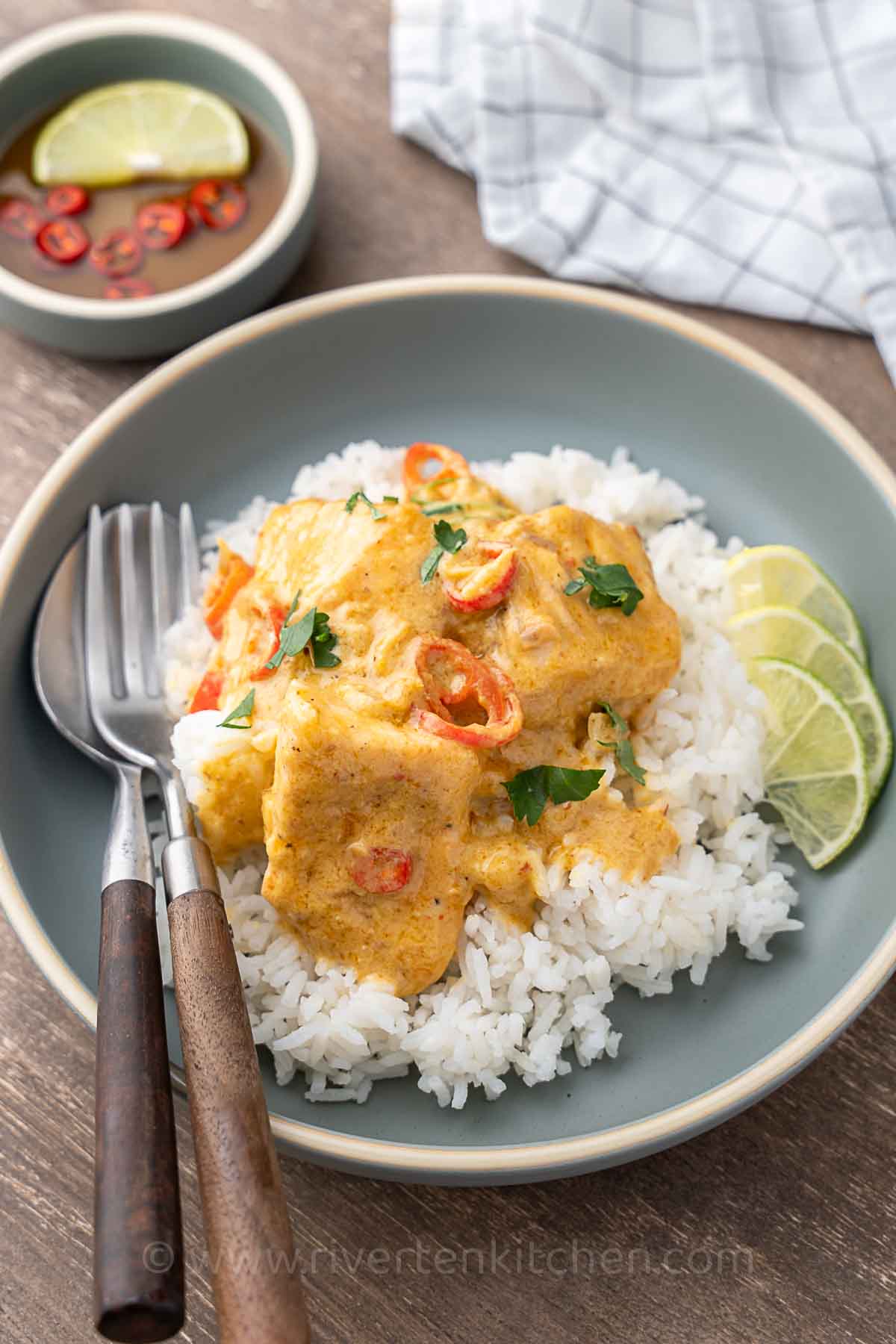
Serve
Serve Thai-style salmon mango curry with fragrant jasmine rice, which absorbs the flavorful curry sauce. For a refreshing touch, drizzle some lime juice over the dish to cut through the richness, adding a tangy and citrusy element. Alternatively, consider serving it with a side of pickled vegetables, providing a delightful contrast in flavors and textures.
Variations
To make it healthier and for added texture, add sweet peppers, spinach, sugar snap peas, and green peas.
Thai red curry paste can be substituted with curry powder which has a milder taste.
To bring the flavors to a whole new level, add fresh kaffir lime leaves, cumin powder, and fresh lemongrass.
Thai Recipes
Salmon Recipes
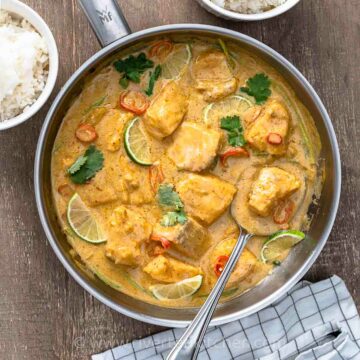
Coconut Curry Salmon with Mango (Thai-style)
Ingredients
Salmon
- 1 pound salmon fillets (cut into 1-inch pieces)
- 1 teaspoon oil
- ¼ teaspoon salt
- black pepper (to taste)
- ½ teaspoon grated ginger (or 1/4 tsp ground ginger)
- ½ teaspoon grated garlic (or 1/4 tsp garlic powder)
Mango Curry Sauce
- 1 tablespoon vegetable oil (canola)
- 1 medium onion (chopped)
- 1-2 pieces red chilies (sliced)
- 2 tbsp red curry paste (add more if preferred, note 2)
- 1 can 13.5 oz coconut milk
- ½ cup mango puree (preferably 1 fresh ripe mango)
- 2 teaspoon fish sauce
- ¼ piece chicken bouillon (or fish stock or chicken powder, note 3)
- ¼ cup water (optional)
To Serve
- steamed rice
- cilantro/coriander leaves
- lime wedges
Instructions
- Marinate salmon: Slice the salmon fillet into bite-size chunks and pat dry with a paper towel. Drizzle over the oil then toss in salt, pepper, grated ginger and garlic. Set aside for 10 minutes. Meanwhile, prepare the other ingredients or pre-heat oven or air-fryer.1 pound salmon fillets, 1 teaspoon oil, 1/4 teaspoon salt, black pepper, 1/2 teaspoon grated ginger, 1/2 teaspoon grated garlic
- Partially cook salmon: There are 3 different ways to do this. Air-fry, bake in the oven, or sear in a pan with hot oil. See note 1 for temperature and cooking time.
Mango Curry Sauce
- Heat vegetable oil in a skillet. Add onion and cook until slightly caramelized. Add red chilies and red curry paste. Stir-fry until fragrant.1 tablespoon vegetable oil, 1 medium onion, 1-2 pieces red chilies, 2 tbsp red curry paste
- Pour coconut milk, mango puree, chicken bouillon and fish sauce. Turn the heat down and simmer until thickened and slightly reduce. Taste the sauce, add more red curry paste depending on the level of spiciness desired or fish sauce to adjust saltiness.1 can 13.5 oz coconut milk, 1/2 cup mango puree, 2 teaspoon fish sauce, 1/4 piece chicken bouillon
- Add salmon and cook for another 3 minutes or until salmon is fully cooked. If the sauce gets too thick, add a splash of hot water.
Recipe Notes & Tips:
- Air-fryer – Preheat air-fryer for 3 minutes at 400°F/ 200°C. Air-fry the salmon for 5 minutes. You can line the basket with parchment paper for easy clean-up but note that the fish will sort of have pale somewhat a steamed texture rather than a crispy or browned texture.
- Oven – Preheat oven for 5 minutes at 425°F/ 220°C. Place salmon in a baking tray lined with a greased parchment paper or foil. Broil for 5 minutes.
- Pan-sear – Heat a skillet over medium-high heat until very hot. Add the canola oil then swirl to coat. Add the salmon cubes and sear each side for 2 minutes until nice and brown. Use cooking tongs to flip the fish for convenience.
Riverten Kitchen is a participant in the Amazon Services LLC Associates Program, an affiliate advertising program designed to provide a means for sites to earn advertising fees by advertising and linking to amazon.com.

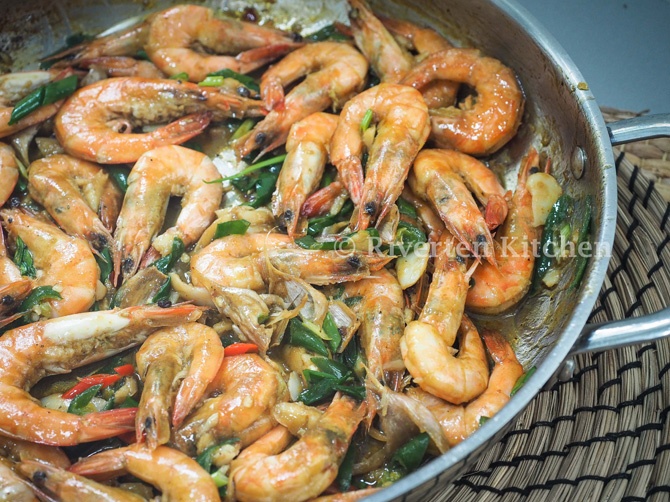
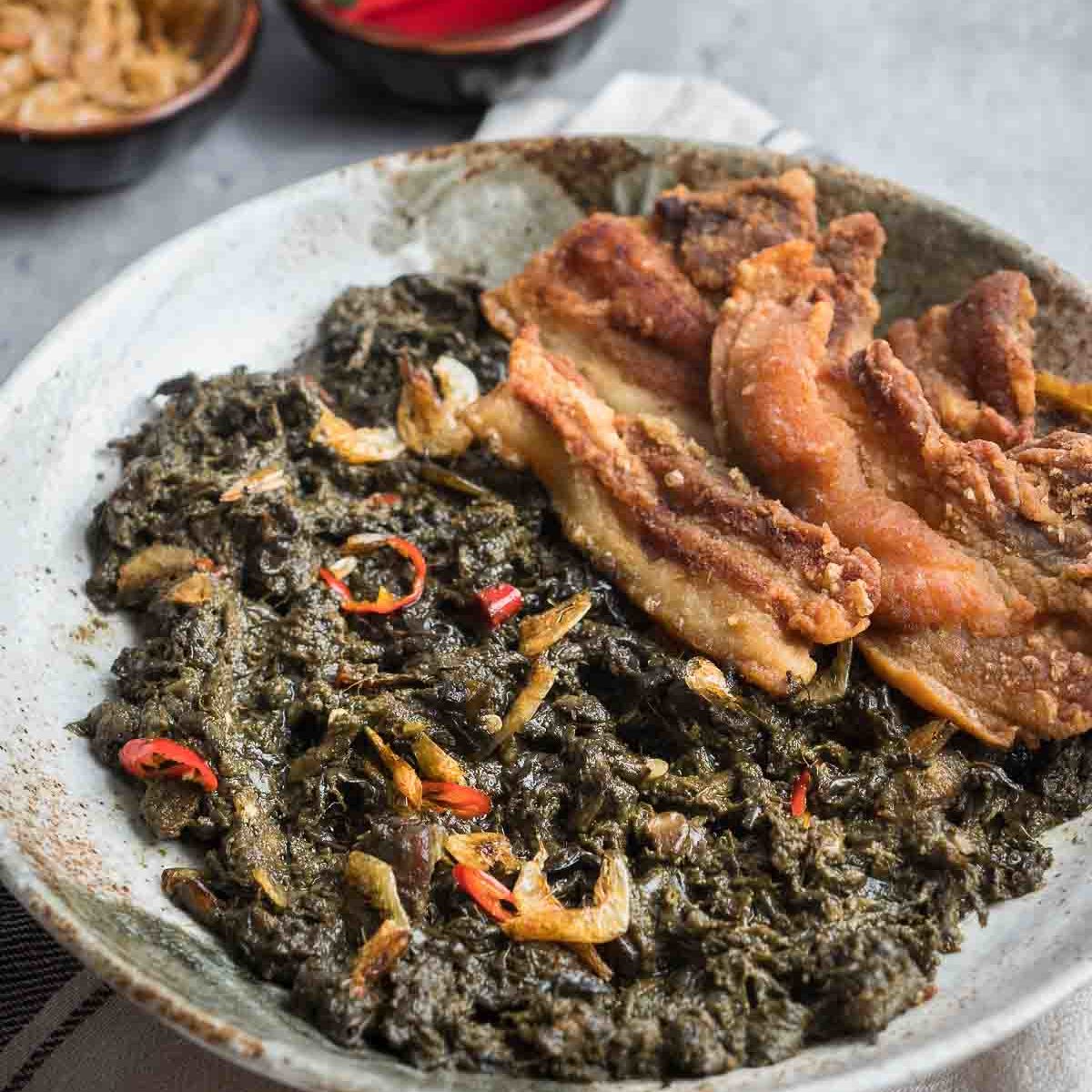
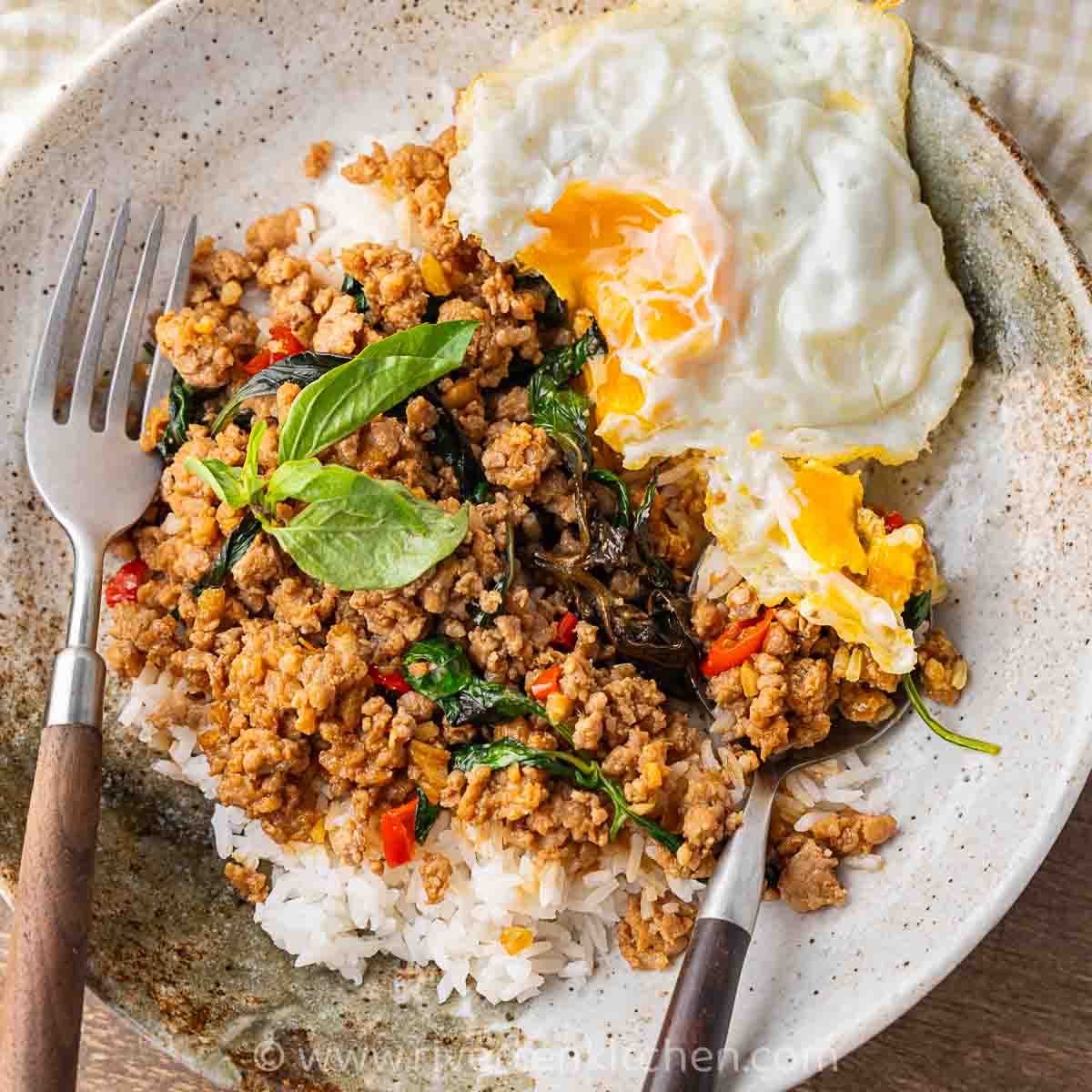
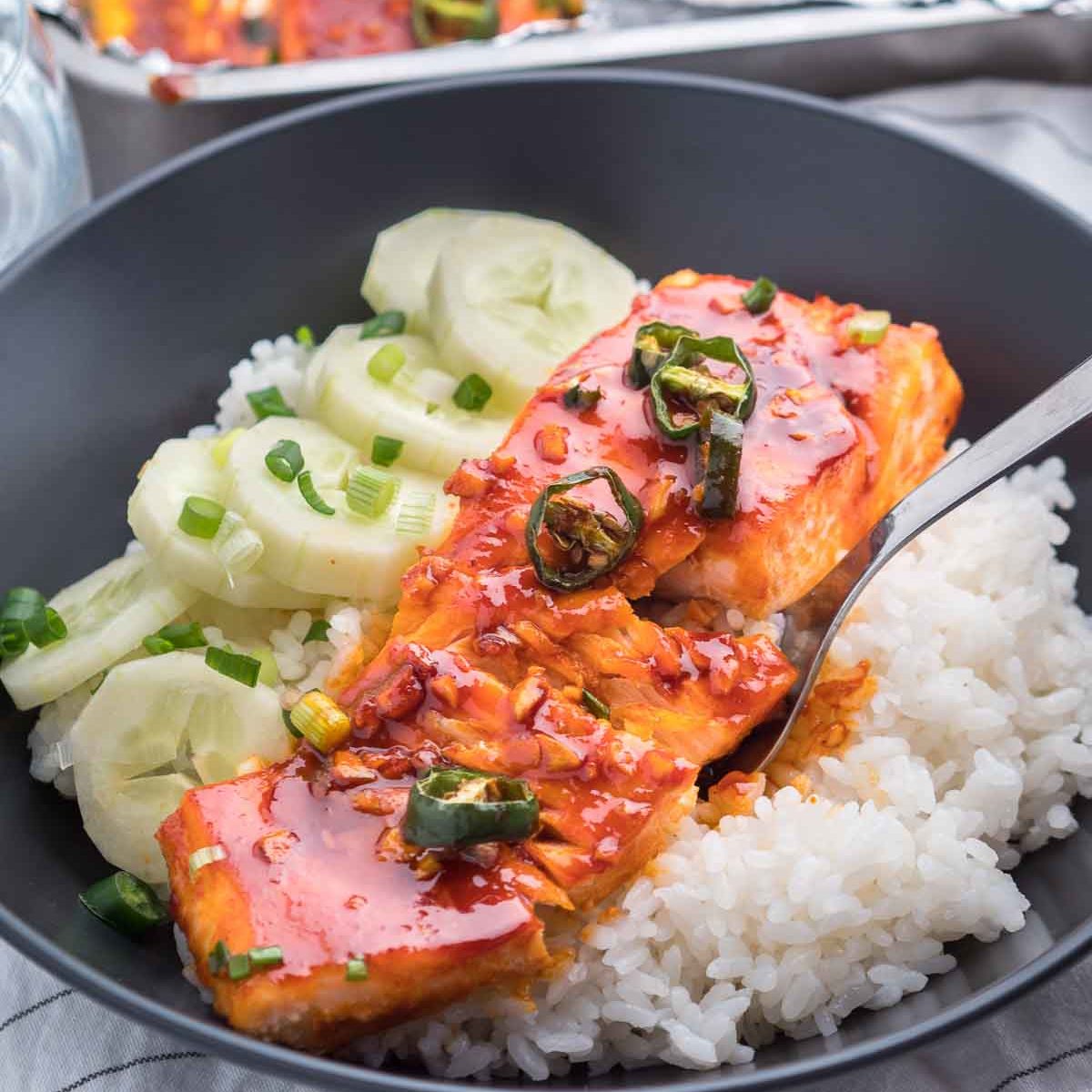
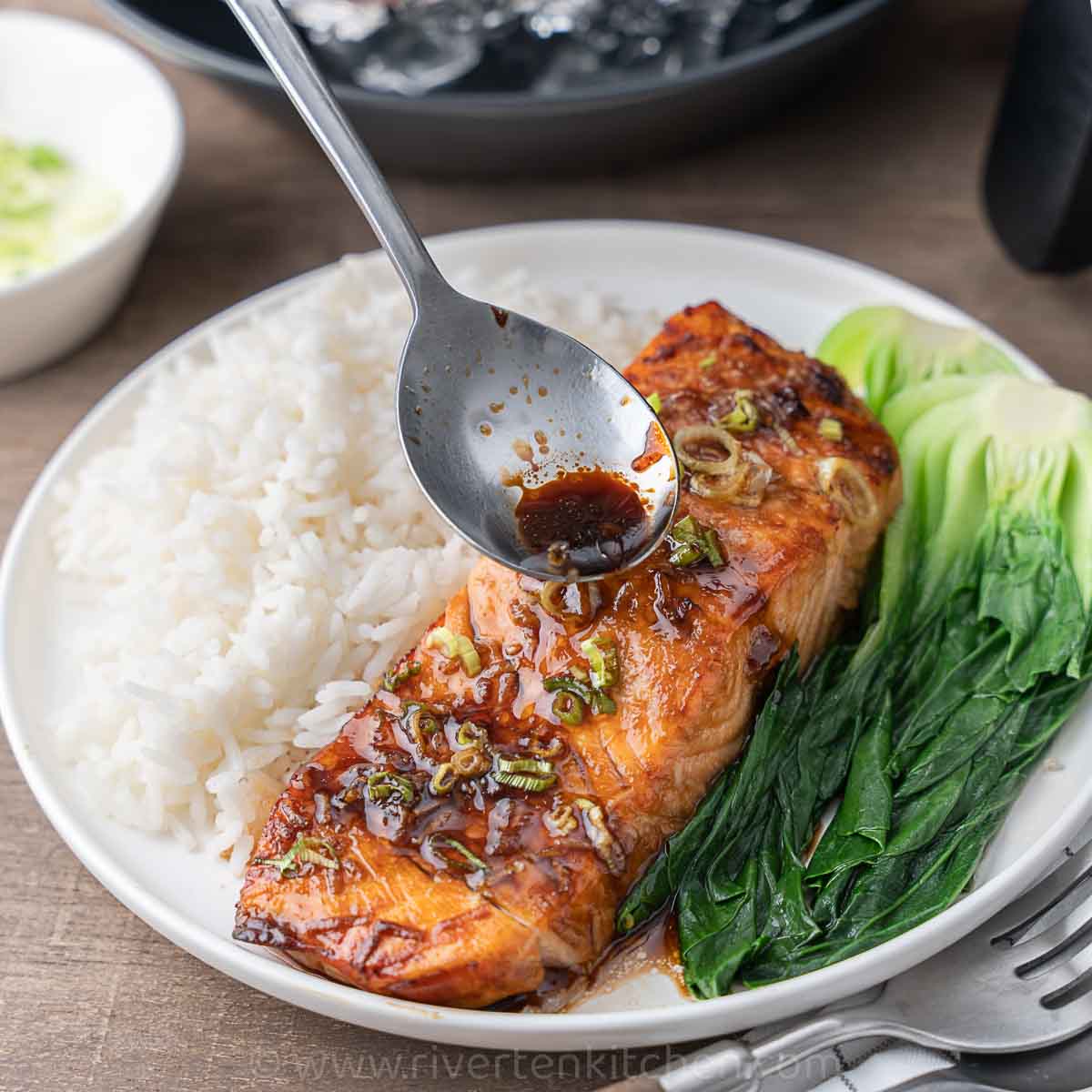
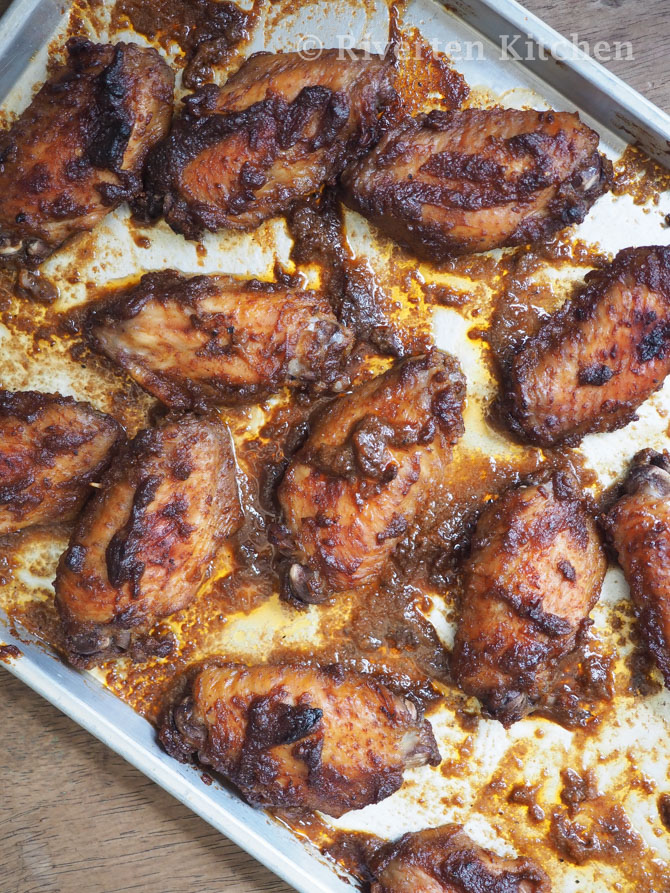
YUM! 😋 Made this two nights in a row. So easy to make with wonderful flavor.
Glad to hear you enjoyed this recipe, Lisa! Happy cooking 🙂
– Mella
Good flavor combination. I was hesitant at first but it turned out so good! Added a bit curry paste to make it more spicy.